AI Podcast on our Cutting-edge Quantum Devices
Enjoy!
The Thermodynamic Tango
Enjoy !
ai loves our papers
(piloted by H. Jonathan Mannhart)
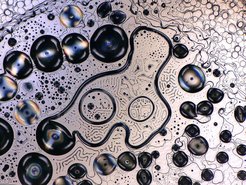
Sapphire amoeba:
Optical image of a recrystallized sapphire surface.
Using a CO2 heating laser, substrates for thin-film growth can be heated to very high temperatures. The laser can easily melt sapphire (Al2O3), which happens at a temperature of 2040 °C. After sustaining a small ‘melt pool’ on the sample surface for about 15 minutes, the laser was switched off abruptly. This rapidly freezes the molten surface, yielding a variety of objects in many shapes and sizes. In this particular image, spherical drops surround a mesa-type structure, reminiscent of a single-cell biological organism on the verge of dividing, given the two cores. The shapes and sizes of such structures are dictated by the balance of surface energies in a solid-state crystal.
Optical image of a recrystallized sapphire surface.
Using a CO2 heating laser, substrates for thin-film growth can be heated to very high temperatures. The laser can easily melt sapphire (Al2O3), which happens at a temperature of 2040 °C. After sustaining a small ‘melt pool’ on the sample surface for about 15 minutes, the laser was switched off abruptly. This rapidly freezes the molten surface, yielding a variety of objects in many shapes and sizes. In this particular image, spherical drops surround a mesa-type structure, reminiscent of a single-cell biological organism on the verge of dividing, given the two cores. The shapes and sizes of such structures are dictated by the balance of surface energies in a solid-state crystal.
© MPI-FKF

Sapphire Hanoi towers:
Optical image of a recrystallized sapphire surface.
Using a CO2 heating laser, substrates for thin-film growth can be heated to very high temperatures. The laser can easily melt sapphire (Al2O3), which happens at a temperature of 2040 °C. After sustaining a small ‘melt pool’ on the sample surface for about 15 minutes, the laser was switched off abruptly. This rapidly freezes the molten surface, yielding a variety of objects in many shapes and sizes. In this particular image, stacks of disks have emerged, reminiscent of the disk-stacking puzzle of the ‘Hanoi towers’ (inset). The shapes and sizes of such structures are dictated by the balance of surface energies in a solid-state crystal.
Optical image of a recrystallized sapphire surface.
Using a CO2 heating laser, substrates for thin-film growth can be heated to very high temperatures. The laser can easily melt sapphire (Al2O3), which happens at a temperature of 2040 °C. After sustaining a small ‘melt pool’ on the sample surface for about 15 minutes, the laser was switched off abruptly. This rapidly freezes the molten surface, yielding a variety of objects in many shapes and sizes. In this particular image, stacks of disks have emerged, reminiscent of the disk-stacking puzzle of the ‘Hanoi towers’ (inset). The shapes and sizes of such structures are dictated by the balance of surface energies in a solid-state crystal.
© MPI-FKF
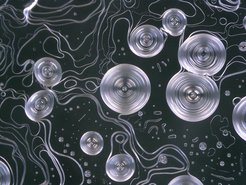
Sapphire rice fields:
Optical image of a recrystallized sapphire surface.
Using a CO2 heating laser, substrates for thin-film growth can be heated to very high temperatures. The laser can easily melt sapphire (Al2O3), which happens at a temperature of 2040 °C. After sustaining a small ‘melt pool’ on the sample surface for about 15 minutes, the laser was switched off abruptly. This rapidly freezes the molten surface, yielding a variety of objects in many shapes and sizes. In this particular image, spherical drops are spread out on a landscape of flat terraces with curvy edges. One can imagine these as microscopic versions of the rice-growing fields, commonly observed in the hills of Southeast Asia. The shapes and sizes of such structures are dictated by the balance of surface energies in a solid-state crystal.
Optical image of a recrystallized sapphire surface.
Using a CO2 heating laser, substrates for thin-film growth can be heated to very high temperatures. The laser can easily melt sapphire (Al2O3), which happens at a temperature of 2040 °C. After sustaining a small ‘melt pool’ on the sample surface for about 15 minutes, the laser was switched off abruptly. This rapidly freezes the molten surface, yielding a variety of objects in many shapes and sizes. In this particular image, spherical drops are spread out on a landscape of flat terraces with curvy edges. One can imagine these as microscopic versions of the rice-growing fields, commonly observed in the hills of Southeast Asia. The shapes and sizes of such structures are dictated by the balance of surface energies in a solid-state crystal.
© MPI-FKF
Gallery

Illustration of an electron wave that has left a contact and now passes a quantum ring.
© MPI-FKF
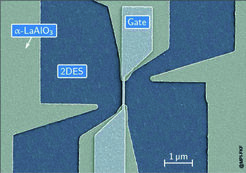
False-colored SEM image of an oxide field-effect transistor with a gate-length of ~ 70 nm (sample by Carsten Woltmann, PhD thesis).
© MPI-FKF
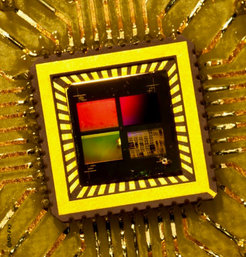
Photograph of an oxide chip containing several hundred thousand LaAlO3 - SrTiO3 field effect transistors. The colors are caused by light interfering with the transistor arrays (Carsten Woltmann).
© MPI-FKF
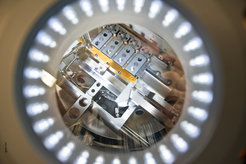
View into our pulsed-laser deposition system (target manipulator).
© MPI-FKF

Top-view of a diamond used in a diamond anvil-cell with back irradiation (Jone Zabaleta).
© MPI-FKF
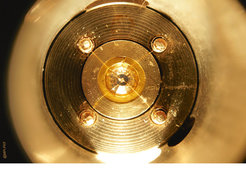
View of a thin-film sample mounted on a diamond in a diamond-anvil cell (Jone Zabaleta).
© MPI-FKF
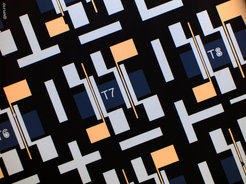
Optical microscope image of oxide field-effect transistors (LaAlO3-SrTiO3) made by Lukas Kürten.
© MPI-FKF

Photograph of a hot tungsten filament designed for a thermoelectronic generator (Alex Kyriazis).
© MPI-FKF
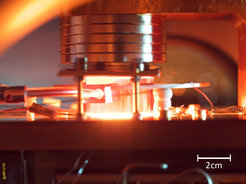
Photograph of a thermoelectronic energy converter in action.
© MPI-FKF

Thermolelectronic generator built to analyze in-situ and under operating conditions the work functions of quantum material heterostructures grown in our pulsed laser deposition system.
© MPI-FKF
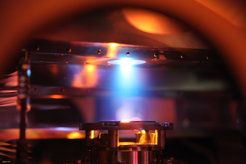
Photograph of the laser ablation process in the PLD chamber.
The invisible, ultraviolet beam of an excimer laser hits a SrTiO3 target so that it shines as a blue disk (middle, top), creating a plasma plume (blue) which extends towards the substrate, a crystal of SrTiO3 (white rectangle in the middle, bottom).
A second invisible infrared laser beam heats the substrate to 1200°C, so that it glows white.
The invisible, ultraviolet beam of an excimer laser hits a SrTiO3 target so that it shines as a blue disk (middle, top), creating a plasma plume (blue) which extends towards the substrate, a crystal of SrTiO3 (white rectangle in the middle, bottom).
A second invisible infrared laser beam heats the substrate to 1200°C, so that it glows white.
© MPI-FKF
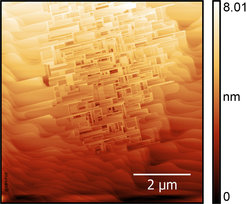
AFM micrograph of a NdGaO3 surface after heating to 1050 °C in 7.5 Pa of oxygen.
© MPI-FKF

Sketch of envisioned solid-state/liquid-state heterostructures. This cross section illustrates the freedom of design and advances achievable if microscopic volumes of liquids (colored) were integrated into heterostructures. In the liquid volumes, for example, ions may create electric double layers (center) or move across gaps (sketch at right).
© MPI-FKF
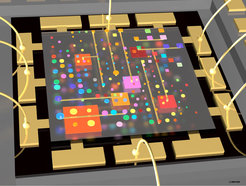
Sketch illustrating the vision of a sample containing integrated, microscopic liquid volumes, as opposed to Fig 2. Different liquids patterned into distinct shapes may be placed onto the sample at well-determined locations and then overgrown by subsequent layers.
© MPI-FKF
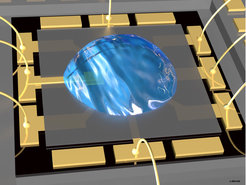
Illustration of a typical state-of-the-art sample setup used for ionic gating. A macroscopic drop of an electrolyte (blue) dropped onto the sample provides the gate liquid.
© MPI-FKF
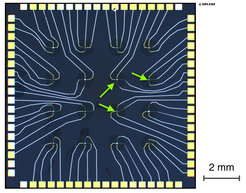
Optical microscopy image of a capacitor with integrated NaCl-H2O dielectric of ≈20 μm diameter (green arrow).
© MPI-FKF
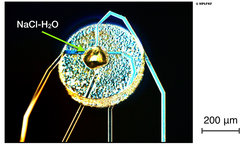
Photograph of a sample with 16 integrated capacitors after deposition of NaCl, before H2O deposition. The green arrows point to three of the capacitors (small bright dots).
© MPI-FKF

Top: Optical microscopy images of a ZnO-field-effect transistors with integrated NaCl-H2O dielectrics (arrow). These transistors have channel lenghts l≈10–20 μm.
Bottom: Optical microscopy images of a chip containing 16 FETs.
Bottom: Optical microscopy images of a chip containing 16 FETs.
© MPI-FKF
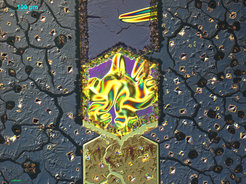
Optical micrograph of a test sample used for the development of integrated liquid solid heterostructures. Advanced Materials 30, 1802598 (2018)
© MPI-FKF
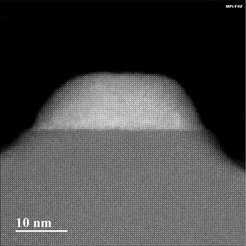
HAADF STEM image of a SrRuO3 quantum dot with the size of 30 nm grown on (100) SrTiO3.
© MPI-FKF
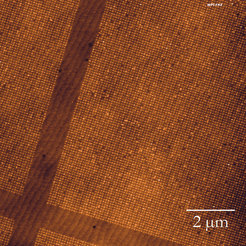
AFM micrograph of epitaxially-grown SrRuO3 nanodot arrays on SrTiO3. Atomic terraces of the substrate are visible. The width of the terrace is ≈ 250 nm.
© MPI-FKF
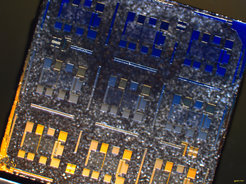
Optical micrograph of a 5x5mm LaAlO3-SrTiO3 sample containing nine devices which consist of FETs combined with Hall bars. Each device comprises a conducting channel of crystalline LaAlO3. The channel is well visible as a translucent area offset from the rest of the sample surface, which is covered with amorphous LaAlO3. The source and drain contacts and the voltage probes of the devices are provided by titanium films. The top-gates consist of PLD-grown gold. The diffuse, grainy background is due to the unpolished bottom face of the SrTiO3 substrate. Sample fabrication and micrograph: Lukas Kuerten.
© MPI-FKF
























